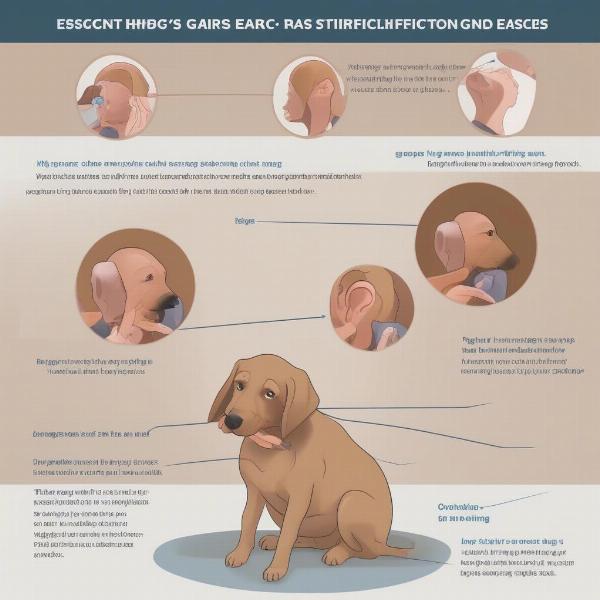Dog ears come in a fascinating variety of shapes and sizes, each contributing to a breed’s unique appearance and sometimes even reflecting its temperament or working ability. A dog’s ear silhouette, whether pointy and erect, long and floppy, or somewhere in between, is more than just an aesthetic feature. It plays a crucial role in their communication, hearing, and overall well-being. Understanding the different dog ears silhouette types can give owners insight into their dog’s breed characteristics and potential health concerns.
Decoding the Different Dog Ears Silhouettes
Canine ear shapes can be broadly classified into several distinct categories, each with its own unique silhouette. Prick ears, commonly seen in breeds like German Shepherds and Huskies, stand erect and point upwards, giving the dog an alert and attentive appearance. Drop ears, characteristic of Basset Hounds and Cocker Spaniels, hang down loosely, often contributing to a gentle and friendly expression. Button ears, like those of the Jack Russell Terrier, fold over at the tip, creating a partially erect and partially dropped appearance. Rose ears, found in breeds like Greyhounds and Whippets, fold back against the head, showcasing a smooth and streamlined profile. Lastly, cropped ears, a controversial practice primarily performed for cosmetic reasons, are surgically altered to create an erect and pointed shape. This practice has been banned in many countries due to ethical concerns surrounding animal welfare. Recognizing these basic shapes is the first step in understanding the diverse world of dog ears silhouettes.
How Ear Shape Influences Canine Communication
A dog’s ears are expressive tools, playing a vital role in their communication. The subtle movements of their ears, combined with their overall body language, can convey a wealth of information about their emotional state and intentions. Erect ears often signal alertness and focus, while flattened ears may indicate fear or submission. Rapidly twitching ears can suggest excitement or anxiety. Understanding these subtle cues can help owners better interpret their dog’s communication and strengthen their bond.
The Role of Ear Shape in Canine Hearing
Beyond communication, the shape of a dog’s ears also influences their hearing ability. Dogs with erect ears, like German Shepherds, are particularly adept at locating sounds due to their ability to swivel their ears towards the source. Drop ears, on the other hand, can sometimes muffle sounds, particularly high-frequency noises. This difference in hearing acuity has implications for a dog’s ability to perform specific tasks, such as hunting or guarding. dog canvas
Health Considerations Related to Dog Ears
Certain ear shapes can predispose dogs to specific health issues. Dogs with long, floppy ears, like Cocker Spaniels, are more prone to ear infections due to reduced airflow and increased moisture within the ear canal. Regular ear cleaning and proper ventilation are essential for maintaining ear health in these breeds. necklace with dog paw
What Does Your Dog’s Ear Silhouette Tell You?
By observing your dog’s ear silhouette, you can gain valuable insights into its breed characteristics, communication style, and potential health concerns. While ear shape alone doesn’t tell the whole story, it’s a fascinating piece of the puzzle that contributes to each dog’s unique individuality.
 Checking a dog's ears for health problems.
Checking a dog's ears for health problems.
Conclusion
From the pricked ears of a vigilant German Shepherd to the floppy ears of a gentle Basset Hound, dog ears silhouettes are as diverse as the breeds themselves. Understanding these differences not only allows us to appreciate the aesthetic variety but also provides valuable insights into canine communication, hearing, and health. By paying attention to these subtle details, we can strengthen our bond with our furry companions and provide them with the best possible care. border collie dog ornaments
FAQ
- Why do some dogs have cropped ears? Cropping ears is primarily done for cosmetic reasons, though some argue it can prevent ear infections. However, it’s a controversial practice with ethical concerns.
- Are dogs with floppy ears more likely to have hearing problems? While floppy ears can muffle some sounds, they don’t necessarily cause hearing problems. They can, however, increase the risk of ear infections.
- How can I tell if my dog has an ear infection? Signs of an ear infection include redness, swelling, discharge, odor, and excessive scratching or head shaking.
- How often should I clean my dog’s ears? The frequency of ear cleaning depends on the breed and individual dog. Consult your veterinarian for specific recommendations.
- Can ear shape affect a dog’s behavior? While ear shape doesn’t directly dictate behavior, it can reflect breed characteristics which may influence temperament and tendencies.
- What are the most common ear shapes in dogs? Some of the most common ear shapes include prick, drop, button, and rose ears.
- Are there any health risks associated with certain ear shapes? Yes, some ear shapes, like floppy ears, can predispose dogs to ear infections.
ILM Dog is your trusted resource for expert advice on all things dog-related, from breed selection and healthcare to training, nutrition, grooming, and accessories. We are dedicated to providing dog owners with the knowledge and resources they need to ensure their furry friends live long, healthy, and happy lives. Whether you’re considering adding a dog peel and stick wallpaper to your home or looking for the perfect dog frame ornament, we have you covered. Contact us for personalized guidance and support: Email: [email protected], Phone: +44 20-3965-8624. ILM Dog is committed to providing the best possible care for your canine companion.